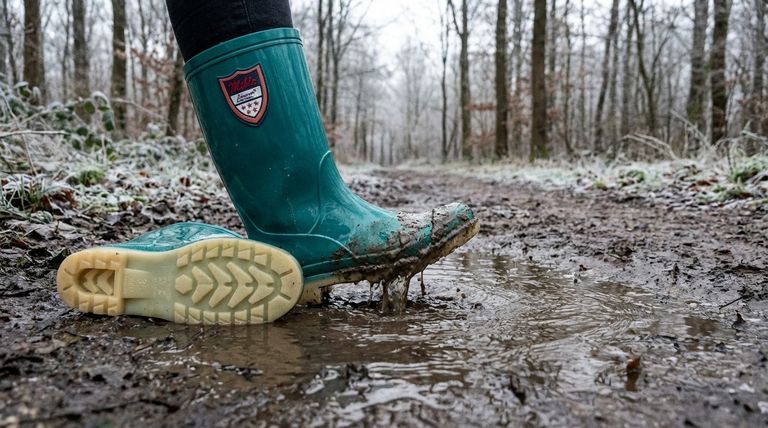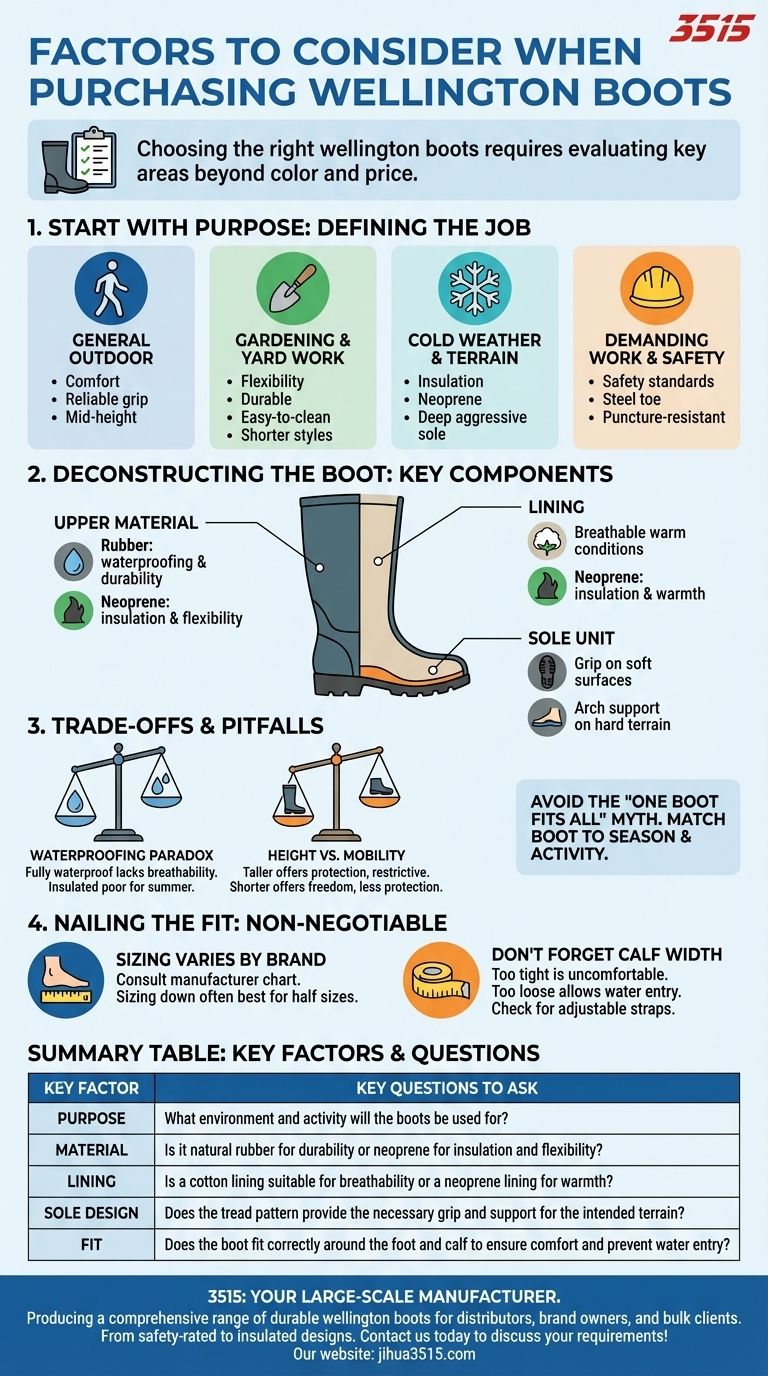Choosing the right wellington boots requires looking beyond color and price. The most effective approach is to evaluate four key areas: your primary purpose for the boots, the materials and lining used in their construction, the design of the sole, and, critically, the precision of the fit, especially around the calf.
The most common mistake is choosing a boot based on a single feature like waterproofing or style. The best decision starts with a clear understanding of the boot's primary mission—the specific environment and activity you need it for—which then dictates every other choice.

Start with Purpose: The Foundational Question
Before examining any boot, you must define its job. A boot designed for a construction site is fundamentally different from one meant for walking the dog.
General Outdoor Use
For daily walks or general use, the priorities are comfort and a reliable grip. A mid-height boot often provides the best balance of protection and flexibility for varied activities.
Gardening and Light Yard Work
Gardening demands flexibility for crouching and kneeling. Look for durable, easy-to-clean materials and consider shorter styles that are easier to slip on and off for quick trips outside.
Cold Weather and Demanding Terrain
For use in cold, snowy, or muddy conditions, insulation becomes paramount. Neoprene-lined boots offer excellent thermal protection, and a deep, aggressive sole pattern is non-negotiable for traction.
Demanding Work and Safety Environments
If the boots are for a work site, your decision must be guided by safety standards. This involves evaluating features like steel toe caps for impact protection and puncture-resistant soles to guard against sharp objects.
Deconstructing the Boot: Key Components Explained
Understanding the anatomy of a wellington boot allows you to make an informed decision based on its construction, not just its appearance.
The Upper Material: Rubber vs. Neoprene
Natural rubber is the classic choice, offering excellent waterproofing and durability. Neoprene, often used in wetsuits, provides not only waterproofing but also significant insulation and flexibility, making it ideal for colder climates.
The Lining: Comfort and Climate Control
The interior lining directly impacts comfort. A simple cotton lining is breathable and suitable for warmer conditions. A neoprene lining, however, provides insulation and is the superior choice for retaining warmth in the cold.
The Sole Unit: Grip, Support, and Flexibility
The outsole is your connection to the ground. A deep, widely spaced tread pattern is designed to shed mud and provide grip on soft surfaces. For harder terrain, look for a sole that offers good arch support and cushioning to prevent fatigue.
Understanding the Trade-offs and Common Pitfalls
No single boot is perfect for every situation. Being aware of the inherent compromises is key to avoiding buyer's remorse.
The Waterproofing Paradox
A fully waterproof boot is, by nature, not breathable. In warm weather, this can trap sweat and lead to discomfort. For this reason, a heavily insulated boot is often a poor choice for summer use.
Height vs. Mobility
Taller boots offer maximum protection from deep water and mud but can feel restrictive during activities that require bending or crouching. Shorter boots provide greater freedom of movement at the cost of less protection.
The "One Boot Fits All" Myth
It is tempting to buy one heavy-duty pair of wellingtons for all tasks. However, using a heavily insulated hunting boot for light summer gardening will be uncomfortable and impractical. Matching the boot to the season and activity is crucial.
Nailing the Fit: A Non-Negotiable Step
An ill-fitting wellington boot is not only uncomfortable but can also fail at its primary job by allowing water to enter from the top.
Sizing Varies by Brand
Never assume your standard shoe size will translate perfectly. Always consult the manufacturer's specific size chart. As a general rule, if you wear a half size, it is often best to size down.
Don't Forget Calf Width
A boot that is too tight on the calf will be uncomfortable and difficult to wear. A boot that is too loose will gape, allowing water, mud, and debris to get inside. Some models offer adjustable calf straps to solve this issue.
Making the Right Choice for Your Goal
With a clear understanding of the core factors, you can now select a boot that serves your specific needs.
- If your primary focus is casual comfort for walks: Prioritize a flexible rubber boot with a comfortable cotton lining and a supportive sole.
- If your primary focus is warmth in cold, wet conditions: Insist on a neoprene-lined boot for its superior thermal properties and deep tread for traction.
- If your primary focus is all-day gardening: Look for a shorter, more flexible boot that is durable and easy to slip on and clean.
- If your primary focus is safety on a job site: Your selection must be guided by required safety ratings, reinforced toes, and puncture-resistant soles.
By matching the boot's design and materials to your specific context, you invest not just in footwear, but in reliable performance and comfort.
Summary Table:
| Key Factor | Key Questions to Ask |
|---|---|
| Purpose | What environment and activity will the boots be used for? (e.g., work site, cold weather, gardening) |
| Material | Is it natural rubber for durability or neoprene for insulation and flexibility? |
| Lining | Is a cotton lining suitable for breathability or a neoprene lining for warmth? |
| Sole Design | Does the tread pattern provide the necessary grip and support for the intended terrain? |
| Fit | Does the boot fit correctly around the foot and calf to ensure comfort and prevent water entry? |
As a large-scale manufacturer, 3515 produces a comprehensive range of durable wellington boots for distributors, brand owners, and bulk clients. Our production capabilities ensure you get the right boots for every purpose—from safety-rated work boots to insulated cold-weather designs. Let us help you source high-performance footwear that meets your specific market needs. Contact us today to discuss your requirements!
Visual Guide

Related Products
- Factory Direct Wholesale Rain Boots Durable Waterproof & Fully Customizable
- Wholesale Anti-Smash & Puncture-Proof Safety Shoes Custom Manufacturing for Brands
- Factory-Direct Wholesale Canvas Boots with High-Traction Rubber Soles
- Premium KPU Injection Athletic Style Safety Shoes
- Premium Wholesale Wheat Nubuck Safety Boot with Rapid Lacing System
People Also Ask
- What are rain boots made of? Discover the best materials for ultimate waterproof protection.
- What factors should be considered when choosing rain boots? Find the Perfect Boot for Your Needs
- What are the main materials used in the production of rain boots? A Guide to Durability & Comfort
- What are the drawbacks of rubber boots regarding breathability and comfort? Understanding the Moisture Trap
- What variety of rubber boots is available? From Rain to Safety and Medical Solutions



















